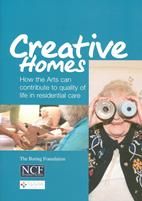Today is a day to celebrate the wonderful art that Imagine has been creating with older people in care homes and the growing movement of creative ageing in residential care. But I also want to ask how high quality arts in care homes can become the norm and not the noble exception?
Before turning to the work that the Baring Foundation is supporting I want to recognise that we are just one piece of the jigsaw. Much else is happening of great value. To name but a few there are: HenPower projects run by Equal Arts and their ambition to create a care home for artists; the residencies created by Magic Me (the specialist in intergenerational arts) and Punchdrunk Entertainment; a new specialised opera company; and musicians from the Wigmore Hall and City of London Sinfonia playing in care homes. In particular I would like to commend Central and Cecil Homes for having created an in-house arts coordinator post. I could mention many more including very exciting examples outside the UK such as the Comprehensive Services in Helsinki co-locating a public café, workshops and libraries in care homes and the Large Type literary festival in the Netherlands. But I will curb my enthusiasm.
The Baring Foundation is an independent funder dedicated to tackling discrimination and disadvantage by strengthening civil society at home and abroad. Since our inception in 1969 we have funded the arts and in 2010 we have focused our arts programme on participatory arts with older people. Although our programme is not exclusively focussed on care homes, it was evident to us that the 450,000 older people living there (out of a total population of over 11 million people aged 65 and over) are very likely to have particularly strong challenges in accessing the arts.
Our specific work in care homes began in 2011 with a good practice report published with the National Care Forum and the National Activity Providers Association called Creative Homes. We followed this up with an open call for grants to arts organisations to provide a bridge between care homes and their surrounding community. We made sixteen grants across all arts forms, such as immersive theatre by Geraldine Peacock called Tea and Silver Music Clubs by Sage Gateshead.
Our largest specific grants programme is the reason we are here today. In partnership with the Arts Council England we gave four grants of £250,000 each to We Do in Huddersfield, City Arts in Nottingham, Arts and Health in Cornwall and the Isles of Sicily (and subsequently Creative Kernow) and the Courtyard Hereford. These grants tested rather different models and are now closing. Alan Dix of Studio 509 is leading a consultancy to consider what can be learnt from these ambitious and varied projects. This will be published this year.
The model used in this programme by Courtyard Hereford – of artists in residence – proved to be the inspiration for the cARTrefu programme by Age Cymru which we are supporting with the Arts Council Wales. This is one of the largest arts projects with people living with dementia in Europe and in its first phase worked in 120 care homes. A resource pack of ideas for creative projects arising out of cARTrefu has been sent to all care homes in Wales. It has been the subject of an evaluation by Bangor University to be published in October.
You will be hearing more shortly from Evan Dawson, the CE of Live Music Now on their work on an initiative called A Choir In Every Care Home. In its first phase the scientific and artistic case for choirs was well demonstrated. Now in its second phase, LMN choirs led by professional musicians have been running in a small number of care homes and on-line resources for musicians and care staff have just been launched.
We have been trying to think how better we can involve care homes themselves rather than arts organisations whom we know are brimming with enthusiasm and expertise. In this context, our new joint fund with the Arts Council England, Celebrating Age, requires a partnership with and older people’s organisations (including care homes). For several years we have been funding an award for the best use of the arts by a care home run by the National Care Forum. Last year we funded a very successful good practice conference by the two umbrella bodies for care homes. One of the ideas flowing from that has been to fund the Social Care Institute for Excellence to develop a suite of good practice on-line materials for care homes on the use of the arts. I think they have done a great job and this has just been launched.
Through these projects thousands of people living in care homes have had the opportunity to create work with very talented artists. In my view almost as importantly these artists have a new source of artistic stimulus and engagement. And people working in care homes are also sharing in these benefits, developing new talents, getting to know the potential of residents better and gaining greater job satisfaction.
But it would be wrong to stop here. Everyone has a right to be creative and participate in culture, right up to the end of their lives. It should not be limited to those living in the best care homes who are in a small minority.
What more is needed? I won’t hesitate from saying that social care needs much more generous state support, but seeing no sign of this, where else can we look? I believe that the regulators will become ever more insistent about the value of the arts. More importantly, older people themselves and their families need to become more demanding that the arts are an essential part of what makes a decent experience in a care home. We should be realistic that the arts will not always be provided by a funded professional artist but acknowledge the role of volunteers and trained care workers and the increasing opportunity provided by digital arts.
We have not reached an acceptable state of affairs yet when it comes to creativity in care homes, but projects such as Imagine are certainly showing the way.

